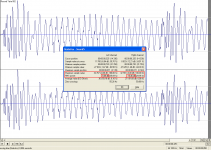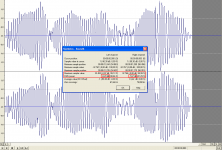Maybe 1:3 means 1 out of 3 seconds, but why didn't write that?They are letting us to find what this means only after we buy the amplifier?
Try that with dubstep music😀 It would be very noticeable.The signal is almost like a continuous sinusoide😀
Completely irrelevant. The average level still has to be at least -9dB anyways, or there'll be no dynamics at all.
If you crank up the volume, you can reach an average level of -2db: with that kind of music, i tried that.And even other kinds of modern music approaches that level for periods much more longer than 1 secondCompletely irrelevant. The average level still has to be at least -9dB anyways, or there'll be no dynamics at all.
Last edited:
If you crank up the volume, you can reach an average level of -2db: with that kind of music, i tried that.
Peak at digital +1dB? I seriously doubt that. Anyways, it's still irrelevant, average level still has to be -9dB.
-2db when 0db is the maximum rms (not peak) power of the amplifier, so if the amplifier has 1000w rms power, the average output of that amplifier is 630w with that kind of signal that im talking about
Last edited:
-2db when 0db is the maximum rms (not peak) power of the amplifier
So actually -5dB average level. Yes, I too have seen this. It's nothing special to dubsteb but common when you deal with amateur sound engineers. Fortunately, whenever it gets in the hands of a proper sound engineer at a recording studio such inane mistakes are corrected to the maximum -9dB level (Actually, -10dB average with absolute max peak at -1dB).
Last edited:
That's just as ridiculous a statement as saying that beer tastes better in glass only half full.
I have never seen specs from any class D amp that did not enter the +1% THD region beyond half rated RMS power.
vac
I have never seen specs from any class D amp that did not enter the +1% THD region beyond half rated RMS power.
I have never seen specs from any class D where +1% THD is reached at half rated RMS power. Please provide links to reputable measurements.
Last edited:
http://www.hypex.nl/docs/nc1200%20folder%20web.pdf
Full power below 1%?
I'm pretty sure you can find a lot more that are 1% far above 1/2 rated power
Full power below 1%?
I'm pretty sure you can find a lot more that are 1% far above 1/2 rated power
On Speakerplans forum I just chatted to few guys saw the internals of PKN 3PHASE amps. He mentioned very large , flat maybe planar inductors wounded by rectangular shaped (at least 1mm X 6mm) copper which expected to be part of the output filters... So surely there is an output filter in the boxes. There are no wires inside but many sandwitched heavy copper multilayer boards. The power supply part is integrated transformer windings+transistors embedded in the base board with more than 12mm(!) thick circuit board. The whole thing looked very strange but also unbelievable compact. Taking picture was not allowed at the moment when the internals displayed.
And the bonus information: these amps are "NOT Class-D"
And the bonus information: these amps are "NOT Class-D"
Last edited:
I'm pretty sure you can find a lot more that are 1% far above 1/2 rated power
Unless there's an error in design or construction, I think it will be reversely impossible to find any class D amp that has 1% THD @ half rated RMS output.
Even the most cheaply built and engineered class D amps I've seen have below 0.1% @ half rated RMS output. Most are far below 0.01% THD at half rated RMS output.
Try that with dubstep music😀 It would be very noticeable.The signal is almost like a continuous sinusoide😀
I think AES should make a standard for measuring the power of an amplifier for short tine and long time.
OK, i've checked dubstep. I found this first (UKF Dubstep Mix - August):
UKF Dubstep Mix - August - YouTube
I searched a loud, sustained bass part, low pass filtered (fcorner=100 Hz), renormalised, and made a statistics (attached). On left channel I found -9.09 dB, which means an average power of 0.246*maximal (sinus) power, so it is a lighter load then the burst used for specification. On right channel the value was only -10.46 dB.
As you can see, the waveform contains sustained signal, but not even close to maximal power (because musicians are not insane).
The hardest music I know in this respect is Mr. Oizo Flat Beat:
Mr. Oizo Flat Beat - YouTube
In the loudest segment I found an average power of 0.341*maximal power on right channel (in bass region).
Do you know anything harder?
Of course I know subwoofer test signals with even worse crest factor, but they are not music, and they will kill the speakers if played on maximal power.
Attachments
One of the greatest failures is the THD% hype of professional amps. Why?
Everyone measures THD% by RESISTIVE loadings while speakers all are fully REACTIVE... sometimes works as a motor, other time just like a generator so THD% measurement on resistor is meaningless!!! I have seen amps with miniscule THD while loaded by resistor which was not able to properly handle the back-EMF of speakers because feedback-control circuit was jammed 🙂
Everyone measures THD% by RESISTIVE loadings while speakers all are fully REACTIVE... sometimes works as a motor, other time just like a generator so THD% measurement on resistor is meaningless!!! I have seen amps with miniscule THD while loaded by resistor which was not able to properly handle the back-EMF of speakers because feedback-control circuit was jammed 🙂
As you can see, the waveform contains sustained signal, but not even close to maximal power (because musicians are not insane).
Amateur sound engineers occasionally compress the music so hard that average levels are even higher. This is probably because they wrongly think it will then be louder which it will not. Since volume is relative, and specifically relative to peak then averages over -9dB will actually sound like lower average volume. Any competent musician and sound engineers will know that.
If you crank up the volume, you can reach an average level of -2db: with that kind of music, i tried that.And even other kinds of modern music approaches that level for periods much more longer than 1 second
Yes, if you heavily overdrive/compress it. Who can afford 40 kW of good speakers, won't do this abuse!
Try to show us such a "music" without overdrive or compression if it exists!
Last edited:
Unless there's an error in design or construction, I think it will be reversely impossible to find any class D amp that has 1% THD @ half rated RMS output.
Even the most cheaply built and engineered class D amps I've seen have below 0.1% @ half rated RMS output. Most are far below 0.01% THD at half rated RMS output.
My brunch today consists of humble pie. Apperently, class D has evolved more than I did. I based my statement on the experience I have with Tripath and some TI chip based amps, but the stuff has moved in since then, I understand now.
vac
Last edited:
True, BUT if some persons at some shows wants more sound pressure, they increase the volume knob by say 6db. The clipping limiter from the amplifier limits the peaks to 0db, but average power rises and could reach more than 0,5x maximal sinus power of the amp with that kind of music. If they have an amplifier that can sustain that power continuous , they will get more decibels. If they have amplifiers designed for 1\3 of power continuous, they will be disappointed.I searched a loud, sustained bass part, low pass filtered (fcorner=100 Hz), renormalised, and made a statistics (attached). On left channel I found -9.09 dB, which means an average power of 0.246*maximal (sinus) power, so it is a lighter load then the burst used for specification. On right channel the value was only -10.46 dB.
As you can see, the waveform contains sustained signal, but not even close to maximal power (because musicians are not insane).
Someone who not own the speakers will certainly do that😀 many deejays and soundmen from my place abuse the speakers even with heavily clipped signals from mixer.Yes, if you heavily overdrive/compress it. Who can afford 40 kW of good speakers, won't do this abuse!
Last edited:
Amateur sound engineers occasionally compress the music so hard that average levels are even higher. This is probably because they wrongly think it will then be louder which it will not. Since volume is relative, and specifically relative to peak then averages over -9dB will actually sound like lower average volume. Any competent musician and sound engineers will know that.
I agree, and I emphase the attribute "amateur"! Fortunately this amplifier is for professionals. 🙂
To add one more thing: high power heats up speaker coils, what makes their impedance much higher (less load for amplifier).
True, BUT if some persons at some shows wants more sound pressure, they increase the volume knob by say 6db. The clipping limiter from the amplifier limits the peaks to 0db, but average power rises and could reach more than 0,5x maximal sinus power of the amp with that kind of music. If they have an amplifier that can sustain that power continuous , they will get more decibels. If they have amplifiers designed for 1\3 of power continuous, they will be disappointed.
Someone who not own the speakers will certainly do that😀 many deejays and soundmen from my place abuse the speakers even with heavily clipped signals from mixer.
Are we talking about deaf DJ's? Are they allowed to control the mixer of a 40 kW+ system? Who will employ them after the first dosens of damaged speaker, and escaped guests? I think you talk about an undersized sound system. If you have 40 kW, then there is no need for overload, and if there are enough speakers, then such a DJ won't be hired!
Anyway: in a good system between the mixer and amplifiers there is a crossover and limiters which can not be controlled by DJ, making impossible to damage speakers and amplifiers. These limiters have to be set to slow release, this way the average power stays te same.
If they have an amplifier that can sustain that power continuous , they will get more decibels.
If they had an amplifier capable of sustain 40 kW, then they would got 40 pcs of fried speakers in some minutes (OK, in some hours, because some time is needed for temporary hearing loss). Speakers are not designed for sustained nominal power. Nor for even the half of it.
Last edited:
- Status
- Not open for further replies.
- Home
- Amplifiers
- Class D
- Largest Class-D amp ever?

